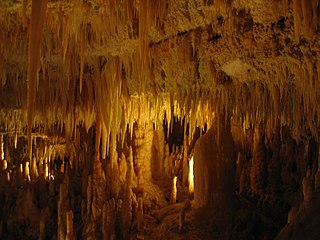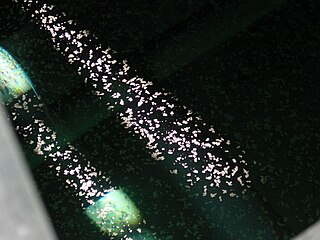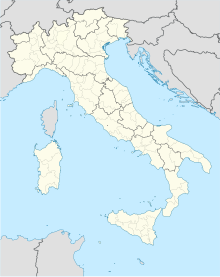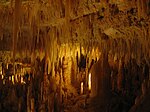
A stalactite is a mineral formation that hangs from the ceiling of caves, hot springs, or man-made structures such as bridges and mines. Any material that is soluble and that can be deposited as a colloid, or is in suspension, or is capable of being melted, may form a stalactite. Stalactites may be composed of lava, minerals, mud, peat, pitch, sand, sinter, and amberat. A stalactite is not necessarily a speleothem, though speleothems are the most common form of stalactite because of the abundance of limestone caves.

A stalagmite is a type of rock formation that rises from the floor of a cave due to the accumulation of material deposited on the floor from ceiling drippings. Stalagmites are typically composed of calcium carbonate, but may consist of lava, mud, peat, pitch, sand, sinter, and amberat.

A speleothem is a geological formation by mineral deposits that accumulate over time in natural caves. Speleothems most commonly form in calcareous caves due to carbonate dissolution reactions. They can take a variety of forms, depending on their depositional history and environment. Their chemical composition, gradual growth, and preservation in caves make them useful paleoclimatic proxies.

A soda straw is a speleothem in the form of a hollow mineral cylindrical tube. They are also known as tubular stalactites. Soda straws grow in places where water leaches slowly through cracks in rock, such as on the roofs of caves. Soda straws in caves rarely grow more than a few millimetres per year and may average one tenth of a millimetre per year. A soda straw can turn into a stalactite if the hole at the bottom is blocked, or if the water begins flowing on the outside surface of the hollow tube. Soda straws can also form outside the cave environment on exposed concrete surfaces as a type of calthemite, growing significantly faster than those formed on rock.

Luray Caverns, originally called Luray Cave, is a cave just west of Luray, Virginia, United States, which has drawn many visitors since its discovery in 1878. The cavern system is generously adorned with speleothems such as columns, mud flows, stalactites, stalagmites, flowstone, and mirrored pools. The caverns are perhaps best known for the Great Stalacpipe Organ, a lithophone made from solenoid-fired strikers that tap stalactites of various sizes to produce tones similar to those of xylophones, tuning forks, or bells.

Flowstones are sheetlike deposits of calcite or other carbonate minerals, formed where water flows down the walls or along the floors of a cave. They are typically found in "solution caves", in limestone, where they are the most common speleothem. However, they may form in any type of cave where water enters that has picked up dissolved minerals. Flowstones are formed via the degassing of vadose percolation waters.

Anthodites (Greek ἄνθος ánthos, "flower", -ode, adjectival combining form, -ite adjectival suffix) are speleothems (cave formations) composed of long needle-like crystals situated in clusters which radiate outward from a common base. The "needles" may be quill-like or feathery. Most anthodites are made of the mineral aragonite (a variety of calcium carbonate, CaCO3), although some are composed of gypsum (CaSO4·2H2O).

Grotta Gigante, also known as Riesengrotte or as Grotta di Brisciachi, is a giant cave on the Italian side of the Trieste Karst (Carso), close to the village of Borgo Grotta Gigante or Briščiki in the municipality of Sgonico. Its central cavern is 107 m (351 ft) high, 65 m (213 ft) wide and 130 m (430 ft) long, putting it in the 1995 Guinness Book of Records as the world's largest show cave. This record was broken in 2010 when La Verna cave in the south west of France was opened to tourists, measuring 255 by 225 by 195 metres.

Illinois Caverns is a state natural area in the New Design Precinct of Monroe County, Illinois. It features Illinois Caverns which is alternatively known as Mammoth Cave of Illinois. Illinois Caverns is the second-largest cave in Illinois and has more than 9.6 km of passages. The cave has a constant temperature of 58 °F (14 °C), and portions flood during wet weather. Passages can be 20 feet (6.1 m) high and just as wide. It is located off Illinois Route 3, south of Waterloo, near the unincorporated community of Burksville.

The Jeita Grotto is a system of two separate, but interconnected, karstic limestone caves spanning an overall length of nearly 9 kilometres (5.6 mi). The caves are situated in the Nahr al-Kalb valley within the locality of Jeita, 18 kilometres (11 mi) north of the Lebanese capital Beirut. Though inhabited in prehistoric times, the lower cave was not rediscovered until 1836 by Reverend William Thomson; it can only be visited by boat since it channels an underground river that provides fresh drinking water to more than a million Lebanese.

The Grotte des Demoiselles is a large cave located in the Hérault valley of southern France, near Ganges, about 60 km (37 mi) west of Nîmes. Its entrance is located on the territory of the commune of Saint-Bauzille-de-Putois.

Castellana Grotte is a town and comune in the Metropolitan City of Bari, Apulia, southern Italy. Grotte means "caves" in Italian.

Rimstone, also called gours, is a type of speleothem in the form of a stone dam. Rimstone is made up of calcite and other minerals that build up in cave pools. The formation created, which looks like stairs, often extends into flowstone above or below the original rimstone. Often, rimstone is covered with small, micro-gours on horizontal surfaces. Rimstone basins may form terraces that extend over hundreds of feet, with single basins known up to 200 feet long from Tham Xe Biang Fai in Laos.
Caving in Tunisia is a relatively rare sport in the country. Caving emerged in the late 1970s and includes a limited number of practitioners. Tunisia has a number of sites suitable for the sport.

Michel Siffre is a French underground explorer, adventurer and scientist. He was born in Nice, where he spent his childhood.

El Soplao is a cave located in the municipalities of Rionansa, Valdáliga and Herrerías in Cantabria, Spain. It is considered unique for the quality and quantity of geological formations (speleothems) in its 17 miles length, 6 of which are open to the public. In it are formations such as helictites and curtains. Its formation dates back to the Mesozoic, in particular the Cretaceous period 240 million years ago. The entrance is at 540 metres in the Sierra Soplao Arnero.

The Villars Cave, in French Grotte de Villars or Grotte du Cluzeau, was occupied during the Lower Magdalenian by Cro-Magnon hunter-gatherers. The cave is part of the French commune of Villars in the northern Dordogne département. Besides its enormous wealth in beautiful stalactites, stalagmites and similar calcite deposits it contains cave paintings and some engravings. The Villars Cave and the Rouffignac Cave are the biggest known cave systems in the Dordogne.

Calcite crystals form on the surface of quiescent bodies of water, even when the bulk water is not supersaturated with respect to calcium carbonate. The crystals grow, attach to one other and appear to be floating rafts of a white, opaque material. The floating materials have been referred to as calcite rafts or "leopard spots".

The Grotte de Rosée is located near Éhein in the municipality of Engis, in Belgium. It has been classified as Wallonia's patrimoine immobilier exceptionnel de la Région wallonne, and can be visited only by accredited scientists.

Calthemite is a secondary deposit, derived from concrete, lime, mortar or other calcareous material outside the cave environment. Calthemites grow on or under, man-made structures and mimic the shapes and forms of cave speleothems, such as stalactites, stalagmites, flowstone etc. Calthemite is derived from the Latin calx "lime" + Latin < Greek théma, "deposit" meaning ‘something laid down’, and the Latin –ita < Greek -itēs – used as a suffix indicating a mineral or rock. The term "speleothem", due to its definition can only be used to describe secondary deposits in caves and does not include secondary deposits outside the cave environment.























